Abstract
We investigated the effects of doxycycline on Toxoplasma gondii infections in vitro and in vivo. Resident peritoneal macrophages were infected with the virulent RH strain of T. gondii and exposed to doxycycline at different concentrations. The antitoxoplasmic activity of doxycycline was first assessed with [3H]uracil, which is incorporated by the parasite but not the host cell. The concentration of doxycycline that inhibited 50% of the radioactive uptake was calculated to be 6.4 micrograms/ml (95% confidence limits, 5.07 to 8.06 micrograms/ml); the concentration of doxycycline that inhibited 90% of the radioactive uptake was 14 micrograms/ml. Tetracycline was ineffective up to 40 micrograms/ml. Furthermore, microscopic examination of the infected macrophages after treatment with doxycycline confirmed the inhibition of intracellular growth of T. gondii. Mice acutely infected by the intraperitoneal route with 5 x 10(3) tachyzoites of T. gondii were protected against death with a dose of 300 mg of doxycycline per kg (body weight) administered by the oral route for 10 days, starting 24 h after challenge. When mice were infected with 10(5) tachyzoites of T. gondii and treated 12 days starting 2 h after challenge, the protection and the cure rates were, respectively, 100 and 0% after doxycycline alone (300 mg/kg per day), 0 and 0% after pyrimethamine alone (12.5 mg/kg per day), and 100 and 60% after the combination of these two drugs at the same dosages given above. These results suggest that doxycycline may prove to be useful in the treatment of toxoplasmic infections.
Full text
PDF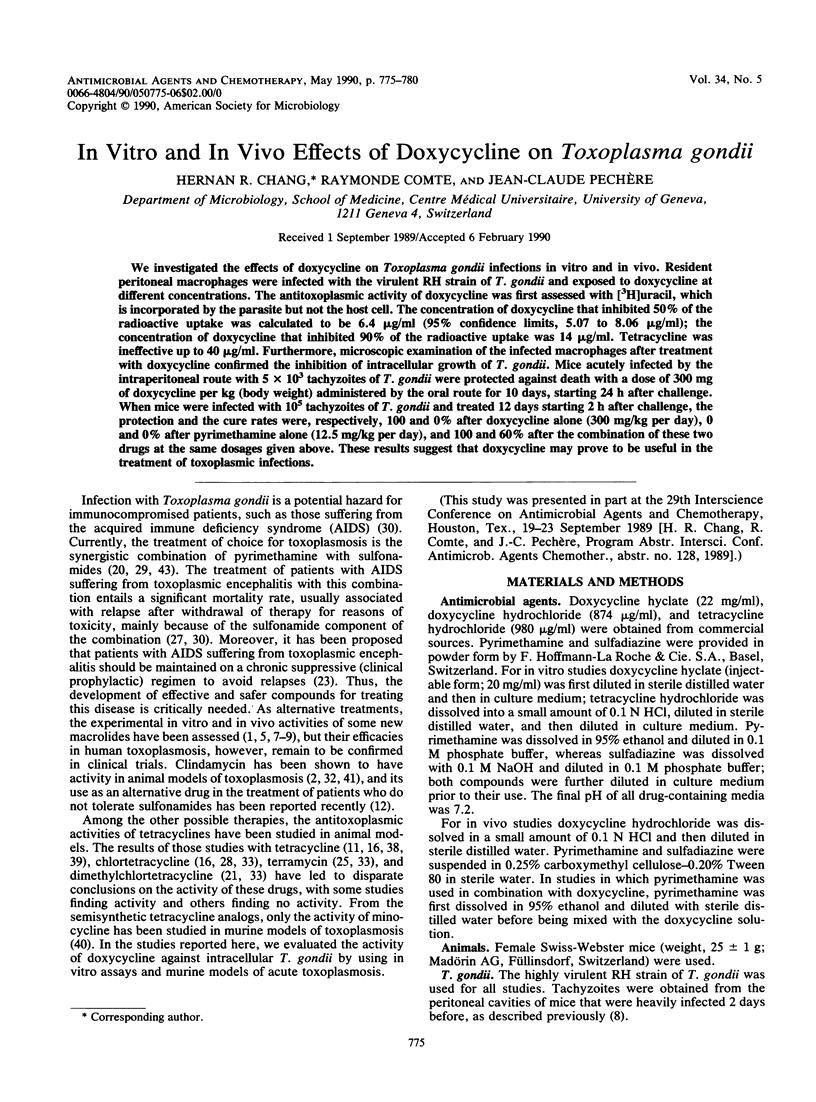
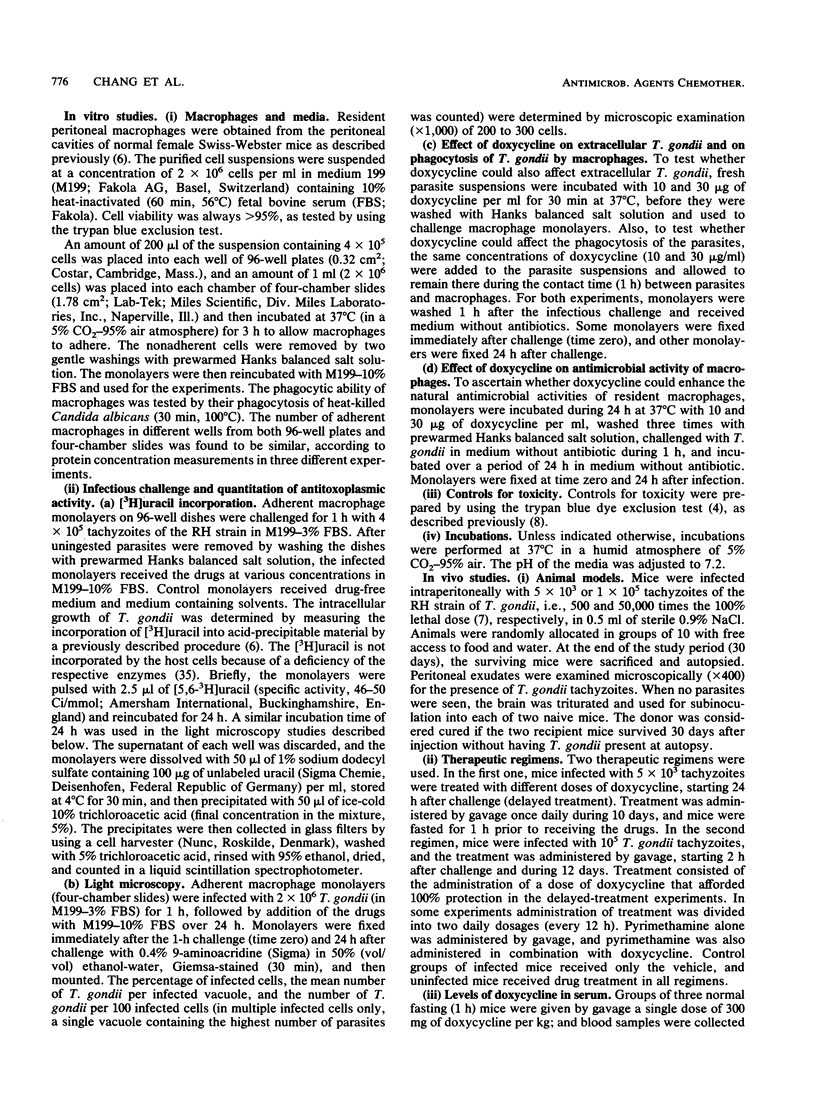
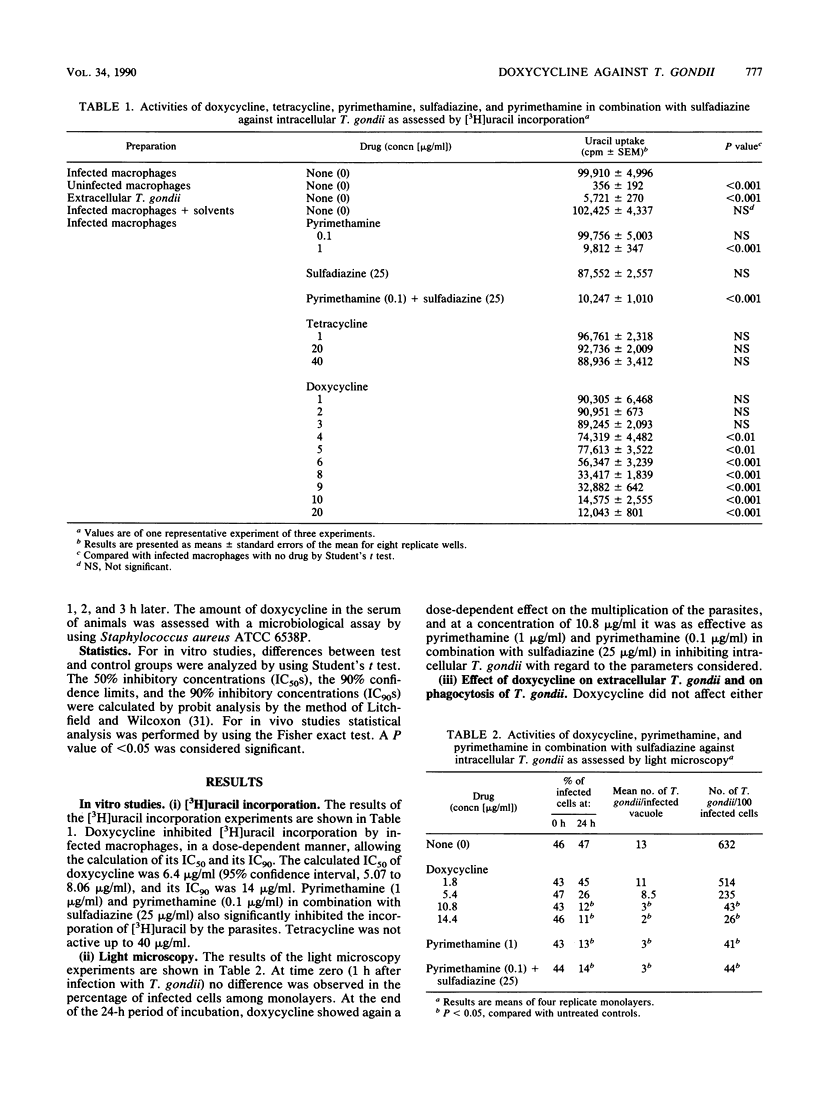
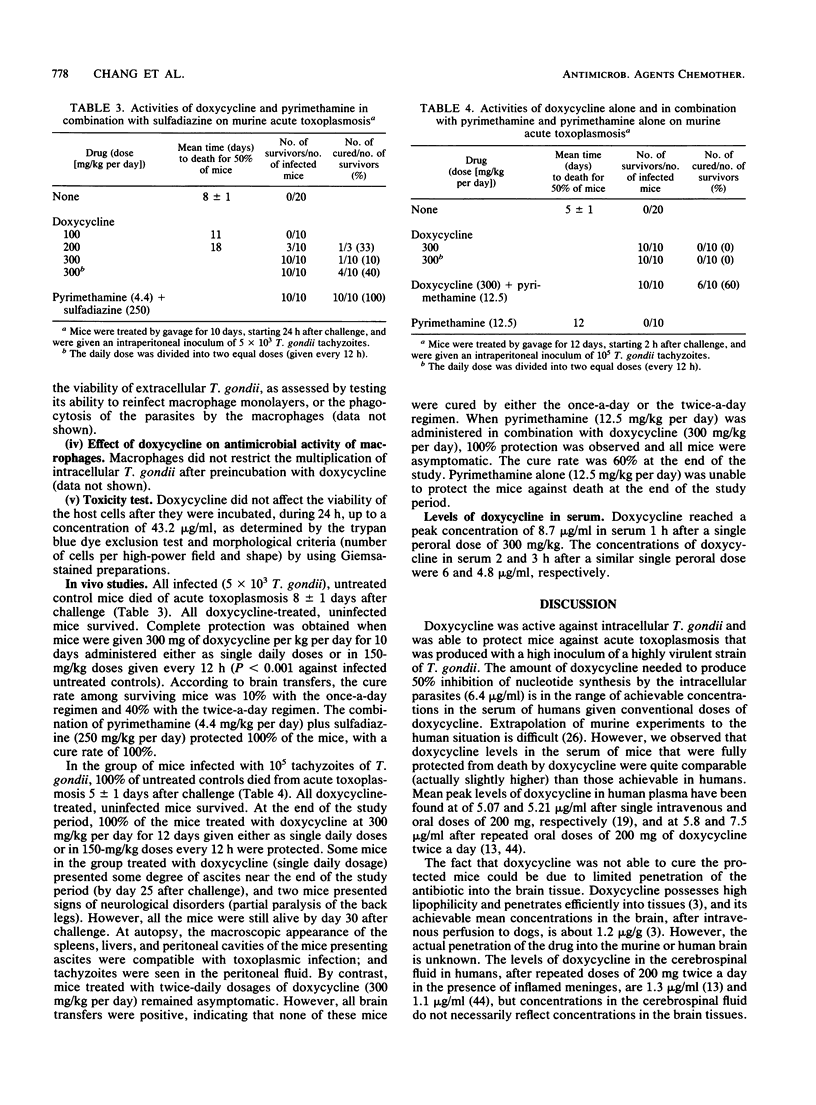
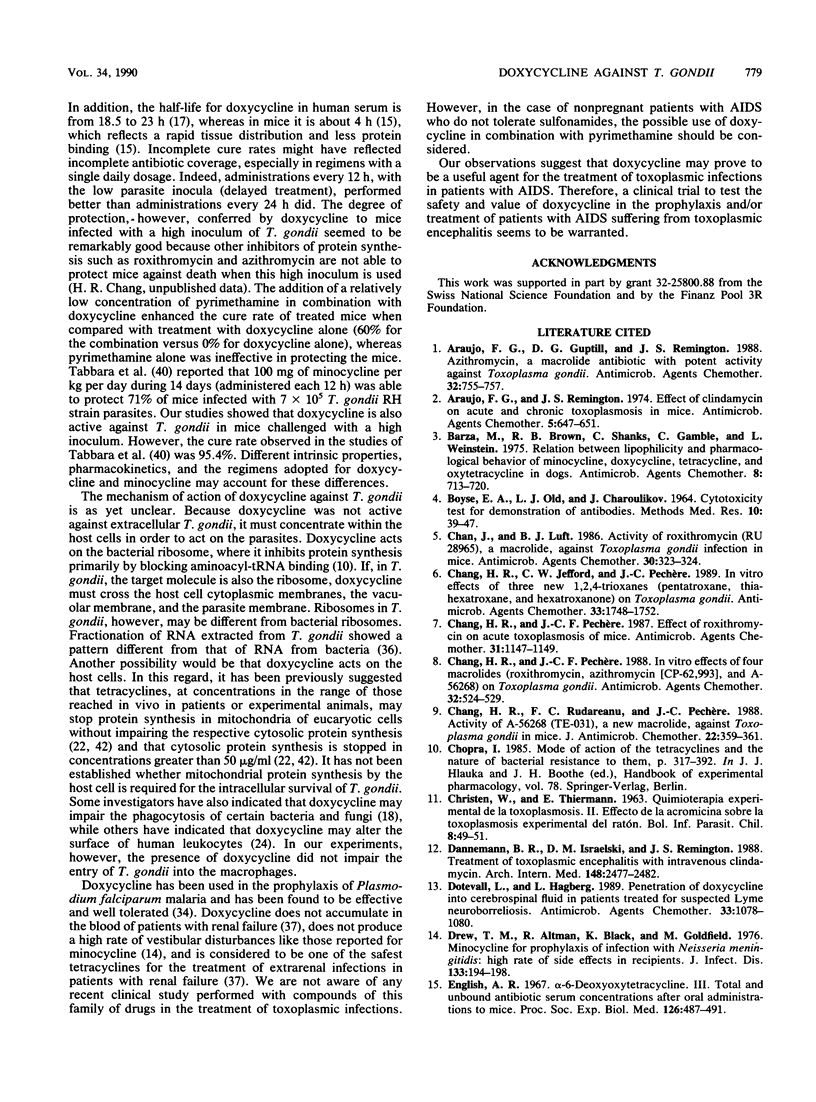
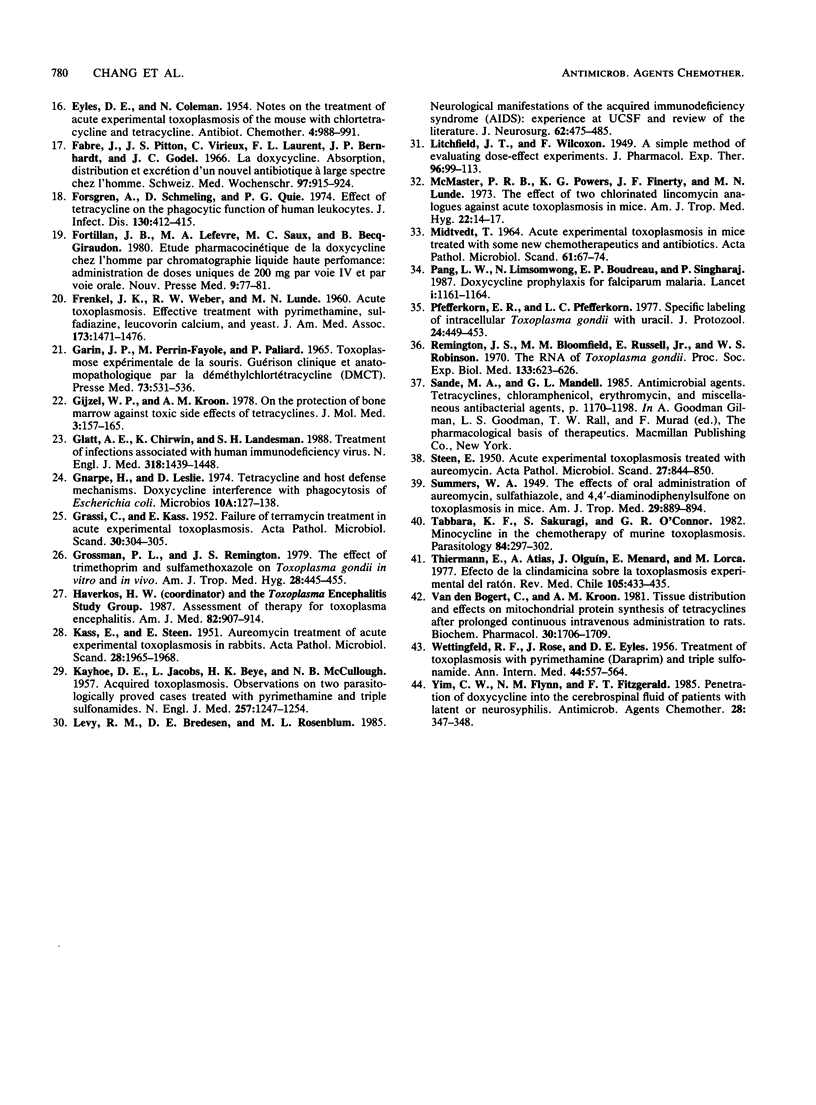
Selected References
These references are in PubMed. This may not be the complete list of references from this article.
- Araujo F. G., Guptill D. R., Remington J. S. Azithromycin, a macrolide antibiotic with potent activity against Toxoplasma gondii. Antimicrob Agents Chemother. 1988 May;32(5):755–757. doi: 10.1128/aac.32.5.755. [DOI] [PMC free article] [PubMed] [Google Scholar]
- Araujo F. G., Remington J. S. Effect of clindamycin on acute and chronic toxoplasmosis in mice. Antimicrob Agents Chemother. 1974 Jun;5(6):647–651. doi: 10.1128/aac.5.6.647. [DOI] [PMC free article] [PubMed] [Google Scholar]
- BOYSE E. A., OLD L. J., CHOUROULINKOV I. CYTOTOXIC TEST FOR DEMONSTRATION OF MOUSE ANTIBODY. Methods Med Res. 1964;10:39–47. [PubMed] [Google Scholar]
- Barza M., Brown R. B., Shanks C., Gamble C., Weinstein L. Relation between lipophilicity and pharmacological behavior of minocycline, doxycycline, tetracycline, and oxytetracycline in dogs. Antimicrob Agents Chemother. 1975 Dec;8(6):713–720. doi: 10.1128/aac.8.6.713. [DOI] [PMC free article] [PubMed] [Google Scholar]
- CHRISTEN R., THIERMANN E. Quimioterapia experimental de la toxoplasmosis. II. Efecto de la acromicina sobre la toxoplasmosis experimental del ratón. Bol Inf Parasit Chil. 1953 Jul-Sep;8(3):49–51. [PubMed] [Google Scholar]
- Chan J., Luft B. J. Activity of roxithromycin (RU 28965), a macrolide, against Toxoplasma gondii infection in mice. Antimicrob Agents Chemother. 1986 Aug;30(2):323–324. doi: 10.1128/aac.30.2.323. [DOI] [PMC free article] [PubMed] [Google Scholar]
- Chang H. R., Jefford C. W., Pechère J. C. In vitro effects of three new 1,2,4-trioxanes (pentatroxane, thiahexatroxane, and hexatroxanone) on Toxoplasma gondii. Antimicrob Agents Chemother. 1989 Oct;33(10):1748–1752. doi: 10.1128/aac.33.10.1748. [DOI] [PMC free article] [PubMed] [Google Scholar]
- Chang H. R., Pechere J. C. Effect of roxithromycin on acute toxoplasmosis in mice. Antimicrob Agents Chemother. 1987 Jul;31(7):1147–1149. doi: 10.1128/aac.31.7.1147. [DOI] [PMC free article] [PubMed] [Google Scholar]
- Chang H. R., Pechère J. C. In vitro effects of four macrolides (roxithromycin, spiramycin, azithromycin [CP-62,993], and A-56268) on Toxoplasma gondii. Antimicrob Agents Chemother. 1988 Apr;32(4):524–529. doi: 10.1128/aac.32.4.524. [DOI] [PMC free article] [PubMed] [Google Scholar]
- Chang H. R., Rudareanu F. C., Pechère J. C. Activity of A-56268 (TE-031), a new macrolide, against Toxoplasma gondii in mice. J Antimicrob Chemother. 1988 Sep;22(3):359–361. doi: 10.1093/jac/22.3.359. [DOI] [PubMed] [Google Scholar]
- Dannemann B. R., Israelski D. M., Remington J. S. Treatment of toxoplasmic encephalitis with intravenous clindamycin. Arch Intern Med. 1988 Nov;148(11):2477–2482. [PubMed] [Google Scholar]
- Dotevall L., Hagberg L. Penetration of doxycycline into cerebrospinal fluid in patients treated for suspected Lyme neuroborreliosis. Antimicrob Agents Chemother. 1989 Jul;33(7):1078–1080. doi: 10.1128/aac.33.7.1078. [DOI] [PMC free article] [PubMed] [Google Scholar]
- Drew T. M., Altman R., Black K., Goldfield M. Minocycline for prophylaxis of infection with Neisseria meningitidis: high rate of side effects in recipients. J Infect Dis. 1976 Feb;133(2):194–198. doi: 10.1093/infdis/133.2.194. [DOI] [PubMed] [Google Scholar]
- English A. R. Apha-6-deoxyocytetracycline. 3. Total and unbound antibiotic serum concentrations after oral administration to mice. Proc Soc Exp Biol Med. 1967 Nov;126(2):487–491. doi: 10.3181/00379727-126-32485. [DOI] [PubMed] [Google Scholar]
- FRENKEL J. K., WEBER R. W., LUNDE M. N. Acute toxoplasmosis. Effective treatment with pyrimethamine, sulfadiazine, leucovorin calcium, and yeast. JAMA. 1960 Jul 30;173:1471–1476. doi: 10.1001/jama.1960.03020310059017. [DOI] [PubMed] [Google Scholar]
- Fabre J., Pitton J. S., Virieux C., Laurencet F. L., Bernhardt J. P., Godel J. C. La doxycycline. Absorption, distribution et excrétion d'un nouvel antibiotique à large spectre chez l'homme. Schweiz Med Wochenschr. 1967 Jul 15;97(28):915–924. [PubMed] [Google Scholar]
- Forsgren A., Schmeling D., Quie P. G. Effect of tetracycline on the phagocytic function of human leukocytes. J Infect Dis. 1974 Oct;130(4):412–415. doi: 10.1093/infdis/130.4.412. [DOI] [PubMed] [Google Scholar]
- Fourtillan J. B., Lefebvre M. A., Saux M. C., Becq-Giraudon B. Etude pharmacocinétique de la doxycycline chex l'homme par chromatographie liquide haute performance. Administration de doses uniques de 200 mg par voie intra-veineuse et par voie orale. Nouv Presse Med. 1980 Jan 10;9(21 Suppl):77–81. [PubMed] [Google Scholar]
- GARIN J. P., PERRIN-FAYOLLE M., PALIARD P. TOXOPLASMOSE EXP'ERIMENTALE DE LA SOURIS. GU'ERISON CLINIQUE ET ANATOMO-PATHOLOGIQUE PAR LA D'EM'ETHYLCHLORT'ETRACYCLINE (DMCT) Presse Med. 1965 Feb 24;73:531–536. [PubMed] [Google Scholar]
- GRASSI C., KASS E. Failure of terramycin treatment in acute experimental toxoplasmosis. Acta Pathol Microbiol Scand. 1952;30(3-4):304–305. doi: 10.1111/j.1699-0463.1952.tb00183.x. [DOI] [PubMed] [Google Scholar]
- Glatt A. E., Chirgwin K., Landesman S. H. Current concepts. Treatment of infections associated with human immunodeficiency virus. N Engl J Med. 1988 Jun 2;318(22):1439–1448. doi: 10.1056/NEJM198806023182206. [DOI] [PubMed] [Google Scholar]
- Gnarpe H., Leslie D. Tetracyclines and host defence mechanisms. Doxycycline interference with phagocytosis of Escherichia coli. Microbios. 1974 Jun-Jul;10A SUPPL(41):127–138. [PubMed] [Google Scholar]
- Grossman P. L., Remington J. S. The effect of trimethoprim and sulfamethoxazole on Toxoplasma gondii in vitro and in vivo. Am J Trop Med Hyg. 1979 May;28(3):445–455. doi: 10.4269/ajtmh.1979.28.445. [DOI] [PubMed] [Google Scholar]
- Haverkos H. W. Assessment of therapy for toxoplasma encephalitis. The TE Study Group. Am J Med. 1987 May;82(5):907–914. doi: 10.1016/0002-9343(87)90151-3. [DOI] [PubMed] [Google Scholar]
- KAYHOE D. E., JACOBS L., BEYE H. K., McCULLOUGH N. B. Acquired toxoplasmosis; observations on two parasitologically proved cases treated with pyrimethamine and triple sulfonamides. N Engl J Med. 1957 Dec 26;257(26):1247–1254. doi: 10.1056/NEJM195712262572601. [DOI] [PubMed] [Google Scholar]
- Levy R. M., Bredesen D. E., Rosenblum M. L. Neurological manifestations of the acquired immunodeficiency syndrome (AIDS): experience at UCSF and review of the literature. J Neurosurg. 1985 Apr;62(4):475–495. doi: 10.3171/jns.1985.62.4.0475. [DOI] [PubMed] [Google Scholar]
- MIDTVEDT T. ACUTE EXPERIMENTAL TOXOPLASMOSIS IN MICE TREATED WITH SOME NEW CHEMOTHERAPEUTICS AND ANTIBIOTICS. Acta Pathol Microbiol Scand. 1964;61:67–74. doi: 10.1111/apm.1964.61.1.67. [DOI] [PubMed] [Google Scholar]
- McMaster P. R., Powers K. G., Finerty J. F., Lunde M. N. The effect of two chlorinated lincomycin analogues against acute toxoplasmosis in mice. Am J Trop Med Hyg. 1973 Jan;22(1):14–17. doi: 10.4269/ajtmh.1973.22.14. [DOI] [PubMed] [Google Scholar]
- Pang L. W., Limsomwong N., Boudreau E. F., Singharaj P. Doxycycline prophylaxis for falciparum malaria. Lancet. 1987 May 23;1(8543):1161–1164. doi: 10.1016/s0140-6736(87)92141-6. [DOI] [PubMed] [Google Scholar]
- Pfefferkorn E. R., Pfefferkorn L. C. Specific labeling of intracellular Toxoplasma gondii with uracil. J Protozool. 1977 Aug;24(3):449–453. doi: 10.1111/j.1550-7408.1977.tb04774.x. [DOI] [PubMed] [Google Scholar]
- Remington J. S., Bloomfield M. M., Russell E., Jr, Robinson W. S. The RNA of toxoplasma gondii. Proc Soc Exp Biol Med. 1970 Feb;133(2):623–626. doi: 10.3181/00379727-133-34531. [DOI] [PubMed] [Google Scholar]
- STEEN E. Acute experimental toxoplasmosis treated with aureomycin. Acta Pathol Microbiol Scand. 1950;27(6):844–850. doi: 10.1111/j.1699-0463.1950.tb00086.x. [DOI] [PubMed] [Google Scholar]
- SUMMERS W. A. The effects of oral administration of aureomycin, sulfathiazole, sulfamerazine and 4,4'-diamino diphenyl sulfone on toxoplasmosis in mice. Am J Trop Med Hyg. 1949 Nov;29(6):889–893. doi: 10.4269/ajtmh.1949.s1-29.889. [DOI] [PubMed] [Google Scholar]
- Tabbara K. F., Sakuragi S., O'Connor G. R. Minocycline in the chemotherapy of murine toxoplasmosis. Parasitology. 1982 Apr;84(Pt 2):297–302. doi: 10.1017/s0031182000044851. [DOI] [PubMed] [Google Scholar]
- Thiermann E., Atias A., Olguin J., Menard E., Lorca M. Efecto de la clindamicina sobre la toxoplasmósis experimental del ratón. Rev Med Chil. 1977 Jul;105(7):433–435. [PubMed] [Google Scholar]
- WETTINGFELD R. F., ROWE J., EYLES D. E. Treatment of toxoplasmosis with pyrimethamine (daraprim) and triple sulfonamide. Ann Intern Med. 1956 Mar;44(3):557–564. doi: 10.7326/0003-4819-44-3-557. [DOI] [PubMed] [Google Scholar]
- Yim C. W., Flynn N. M., Fitzgerald F. T. Penetration of oral doxycycline into the cerebrospinal fluid of patients with latent or neurosyphilis. Antimicrob Agents Chemother. 1985 Aug;28(2):347–348. doi: 10.1128/aac.28.2.347. [DOI] [PMC free article] [PubMed] [Google Scholar]
- van den Bogert C., Kroon A. M. Tissue distribution and effects on mitochondrial protein synthesis of tetracyclines after prolonged continuous intravenous administration to rats. Biochem Pharmacol. 1981 Jun 15;30(12):1706–1709. doi: 10.1016/0006-2952(81)90403-2. [DOI] [PubMed] [Google Scholar]


